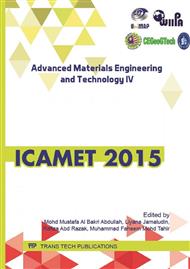p.3
p.8
p.13
p.18
p.22
p.26
p.31
p.36
Intermetallic Study on the Modified Sn-3.5Ag-1.0Cu-1.0Zn Lead Free Solder
Abstract:
Due to environmental concerns, lead-free solders were introduced to replace the lead-based solders in microelectronics devices technology. Although there are many lead-free solders available, the Sn-Ag-Cu solders are considered the best replacement due to their good wettability and joint strength. Although the Sn-Ag-Cu solders are accepted widely, but there are still some room for improvement. In this study, 1wt% Zn, which can be considered high percentage for a dopant, was added into the solder via powder metallurgy route. The effects of adding this dopant into the Sn-3.5Ag-1.0Cu solder on the interface intermetallic and thickness were investigated. The intermetallics phases formed were observed under Scanning Electron Microscope (SEM) and their thicknesses were measured. The SEM results showed the presence of Cu6Sn5, Cu3Sn and (Cu,Zn)6Sn5 intermetallics. It can be concluded that Zn behaved as retarding agent and significantly retarded the growth of Cu-Sn intermetallics.
Info:
Periodical:
Pages:
3-7
Citation:
Online since:
May 2016
Keywords:
Price:
Сopyright:
© 2016 Trans Tech Publications Ltd. All Rights Reserved
Share:
Citation:


